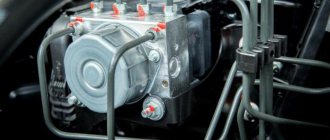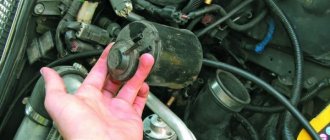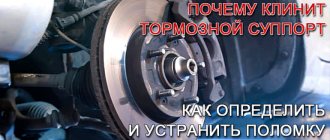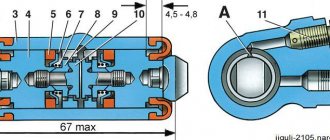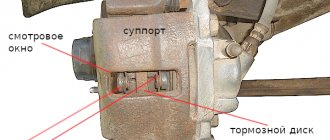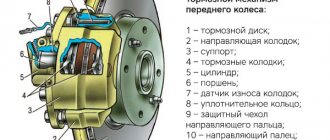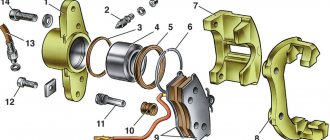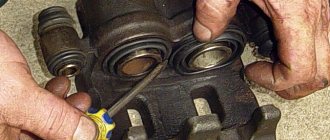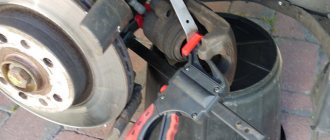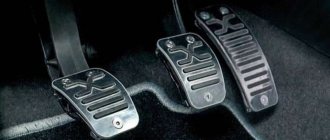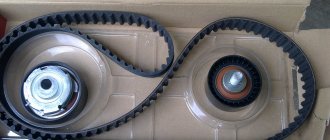Symptoms of mechanism malfunction
The design of this mechanism is very simple, but it is the most important component of the braking system. If the brake caliper of the VAZ-2110 is in good working order and operates in normal mode, then this directly affects the braking distance of the car. In case of sudden braking, you have a chance to win several “golden” meters, which can protect you from a fatal outcome.
Among the main symptoms of breakdowns of this mechanism are the presence of smudges near the front wheel, as well as an increase in braking distance. But similar symptoms can also appear when tubes, hoses are destroyed, or the fluid level in the system decreases. Therefore, before repairing the caliper, you need to make sure that it is faulty.
How to replace the front brake cylinder on a VAZ 2110
Front brake mechanism of VAZ 2110 car
For road safety, the serviceability of the front, rear and hand brakes is of great importance. The brake system of the VAZ 2110 car has a diagonal separation of circuits, which increases reliability and safety when driving a car. If one circuit fails, another effectively replaces it.
Major breakdowns
The front caliper of the VAZ-2110 is a structural element that holds the brake pads and is responsible for the level of pressure of these elements on the metal discs. It also helps ensure even pad wear, which guarantees effective braking in any situation. The body is made of aluminum alloy and the piston is made of steel.
Between these elements there is an oil seal that prevents brake fluid from leaking out of the system. The main caliper failures are as follows:
- The appearance of oxidation on the surface of the guide elements.
- Oxidation on the main piston, which leads to deterioration of the mechanism.
Failure can be identified by uneven wear of the pads, as well as by an increased braking distance. If such malfunctions are detected, be sure to change the pads.
Caliper malfunctions and their symptoms
The “body” of the caliper itself is a fairly reliable design. Mainly moving parts can be damaged: pistons, guides, pad mounting plates. In most cases, the cause of failure is damaged anthers and seals. Let's look at the most common faults.
- The guides jam. In floating-type structures, guides often suffer: due to wear of the boots, water and dirt get on them, mix with lubricant and lead to corrosion and wear. When the guides are not in order, the caliper loses mobility and begins to jam in one position, as a result of which the brake operates harder or “sticks.” You can try to clean soured guides, but more often they are simply replaced with new ones.
- Pistons jam. The cause of jamming is, as a rule, corrosion on the piston and cylinder wall, as well as wear and tear due to water and dirt getting inside. How does she get there? Through a gap in the boot, which was not immediately noticed. If there are obvious signs of corrosion, there is no point in grinding the pistons; you have to replace the entire caliper.
- Brake fluid leak. If the fittings or rubber seals on the piston are worn out, brake fluid leaks through them. The situation can be saved by purchasing new seals (there are ready-made repair kits) and replacing the fluid in the hydraulic system.
- Damage to the pads. The brake pads are installed on mounting plates. Since the load on the brakes is quite large, experts advise changing the plates along with the pads. This will cost less than buying a new set of pads and discs if the plate fails and the pads become misaligned in the mount.
Diagnostics
To check the front brake caliper of the VAZ-2110, you will need to perform the following steps:
- Assess the condition of the metal piston and the ease of its movement inside the cylinder.
- Check for metal oxidation, oxide formations or build-ups, or moisture on the elements.
- Assess the condition of all rubber boots.
- Check the condition of the VAZ-2110 caliper guides. You must make sure that there is no abrasion, deformation or scuffing on their surface.
Any damage to the caliper body and its and other elements should alert the driver. In this case, it is necessary to change the mechanism.
Main causes of malfunction
The VAZ 2110 caliper is structurally an element that holds the brake pads and is responsible for the degree of their pressure on the brake discs. It is also responsible for uniform wear of the brake pads and guarantees the driver reliable braking in extreme situations. Thus, the importance of the caliper in the operation of the car is difficult to overestimate.
If by this time you have a completely reasonable question, what can happen to the caliper on a VAZ 2110 (2112), we will be happy to answer you. The main cause of malfunctions is “acidification” of the moving elements, coating them with an oxide film, clogging due to the destruction of protective boots or the use of improper lubricant, namely:
- acidification of the main piston mechanism;
- acidification of guides.
Piston mechanism and caliper guides VAZ 2110
A clear sign of problems that the caliper can cause on VAZ cars is uneven wear of the brake pads and an increased braking distance. In this case, the VAZ pads must be changed, and the caliper mechanism itself must be subjected to comprehensive diagnostics:
- check the condition of the piston, its degree of freedom, the presence of moisture, metal oxide, oxide formations and build-ups, the condition of the protective boots;
- Similarly, check the condition of the guides, make sure that there are no uncharacteristic scuffs, abrasions or deformations of the rod on the surface.
We must also not forget about regularly replacing the brake fluid in the system. This should be done approximately every 40 thousand km. mileage of VAZ-2110.
Since brake fluid is hygroscopic, it easily absorbs moisture, thereby oxidizing the piston mechanism and causing it to fail. The piston stroke becomes difficult and uneven wear of the brake pads and wheel wedge occurs.
Please note that the repair kit offered in stores for self-service of VAZ 2110 (2112) calipers contains special lubricant for both the main piston and the guides. The use of Lithol or graphite lubricant leads to swelling of the protective shock absorbers and further souring of the guides. This kind of repair is unlikely to benefit your car.
Brake fluid
Any brake fluid that is used in automotive systems absorbs moisture very well. It is hygroscopic, therefore it oxidizes the piston mechanism from the inside, which leads to failure of structural elements. This makes the piston stroke more difficult and the brake pads wear unevenly.
The front wheels may become jammed. For these reasons, it is necessary to replace the brake fluid. Its service life is about 90,000 km, but not more than two years. These solutions contain many useful additives that improve cooling and increase braking efficiency.
But over time, under the influence of high temperatures and pressure, these additives evaporate. And the consistency of the brake fluid becomes more like water, and this reduces the efficiency of the system.
Repair kits
You can purchase special kits designed for caliper repair. But there is no point in purchasing it. It is much better to replace the VAZ-2110 caliper. In this case, you will increase the life of the entire braking system and also improve its reliability. Such repair kits contain the lubricant that is necessary for the piston and guides.
You cannot use graphite lubricant such as CV joint or Litol-24, as this will cause the protective shock absorbers to swell and the guides to simply oxidize. As a result, repairs will not bring the desired effect for a long time.
Removing the caliper
The mechanism is of a very simple design; dismantling can be done without much difficulty. Even a novice motorist can cope with such work. In order to remove the VAZ-2110 caliper, you will need to perform the following steps:
- Loosen the wheel bolts on the side being repaired.
- Raise the side to be repaired using a jack and remove the wheel completely. Install it under the bottom of the car. This will protect you in case the car suddenly falls off the jack.
- Cars of the tenth family have the caliper attached to the bracket using two M17 bolts. They need to be unscrewed. If you can't strip the threads, use a penetrating lubricant.
- Unscrew the brake hose, which is located at the top of the caliper.
When dismantling, evaluate the condition of all rubber tubes. If there is damage on them, even small cracks, it is imperative to install new elements. Such breakdowns can lead to the brake system depressurizing while driving.
Installing a new caliper
Installation of the device is carried out in the reverse order. To do this you need to do the following:
- Install the brake caliper housing and tighten the mounting bolts.
- Tighten the bolts using a 17mm wrench.
- Push back the locking plate and unscrew the bolt with a 13mm wrench to remove half of the caliper.
- The piston must be completely pressed inside the mechanism and new brake pads must be installed.
- Reinstall the caliper half and tighten the nut. Bend the locking plate using a chisel.
- Screw on the brake hose.
- Bleed the entire system to get rid of any air in it.
After bleeding the system, it is imperative to put rubber plugs on the fittings. With their help, these elements are protected from moisture and dust. And the next time you pump, unscrewing the fittings will be much easier.
Caliper repair
If you decide not to replace, but to repair the mechanism, then you can purchase a special kit for this purpose. It consists of the following components:
- Gaskets.
- New piston.
- Guide elements.
The cost of the repair kit is about 500 rubles. And a new caliper for a car of the tenth family, depending on the greed of the seller, may cost 2-3 times higher.
But before installing the new elements that are included in the kit, it is necessary to completely disassemble the VAZ-2110 caliper. To do this you will need to use an air compressor. Connect it to the hole for the brake pipe, and then gradually supply air. It is advisable to install a rubber spacer or a wooden block under the piston. This will avoid a shot, since the piston moves freely.
A similar action can be performed immediately before removing the mechanism. To do this, you do not need to disconnect the caliper from the system; instead of the brake pads, install a small wooden block. Gently press the brake pedal to build up pressure in the system. In this case, you will lose some amount of liquid, but if you were planning to fill in a new one anyway, then this is not a problem.
Installation of a new piston is done using a clamp. Be sure to bend back the boot to avoid damaging it. Before installing the piston, it is necessary to remove contaminants on the internal surfaces with non-aggressive liquids. It is not recommended to use liquid to clean the carburetor, as it can damage rubber and plastic products.
How does a brake caliper work and why is it needed?
Welcome! A brake caliper is essentially a very necessary thing, since practically no car can do without it, because the brake caliper does the most basic work during braking, but not all people know how it works and what will happen if it doesn’t. installed on the car, that’s what we’ll look at today.
Note! At the end, in addition to this article, there is an interesting video clip that shows the entire principle of operation of the brake system!
What is a caliper for and what is its operating principle?
In short, it is needed so that the car slows down when you press the brake pedal and if it is not there, as was said earlier, the car will not stop at all, since the main work of braking is performed by this particular caliper.
Well, if we talk in more detail and, in addition to all this, delve into the principle of its operation, then this very principle of its operation is as follows: when you press the brake pedal, pressure occurs in the brake system, namely the piston which is located in the master brake cylinder ( This cylinder is indicated by the number 3), moves from the beginning of this cylinder to the end, thereby still collecting a little brake fluid that is in the brake reservoir (indicated by the number 5), squeezing the brake fluid forward, it goes through the hoses and thereby squeezes out the pistons that are in the caliper itself, and these pistons press on the brake pads and the car stops.
Let's look at it in more detail, for this let's first look at what this main brake cylinder is, and it represents a structure inside which there is that same piston as well as a rod that presses on it, so when you have to stop the car, you press accordingly on the brake pedal, after pressing the rod will also mix forward, thereby the piston that sits on this rod will mix, and after mixing, all the brake fluid will be pushed forward, as it were, and it will go all the way to the working cylinders themselves, which we will talk about a little lower.
Note! Let us tell you right away so that you understand one thing, this brake fluid is not compressible, so if something does not press on it, it will also press on other parts of the brake system and at the same time it will not compress!
Now the fluid will press from one end, onto all working cylinders to which hoses are connected (Hoses that are connected to the working cylinders are indicated by numbers 2 and 4 in the photo above, which shows a diagram of the brakes of a VAZ 2110 car), so after the brake fluid is the working cylinder is filled, the piston which is located in this cylinder will be squeezed out and thereby put pressure on the brake pad, and the brake pad at this moment will compress the brake disc and therefore friction will occur which stops the car.
And in conclusion, let’s note why a car needs a brake reservoir, namely, thanks to the brake reservoir, which contains the fluid itself and maintains the normal level of this fluid in the system, to understand more, look at the photo located just below:
Where is the brake caliper located?
On many cars it is different, sometimes this caliper is located in the front part of the car, and sometimes in the front and rear at the same time, and on some cars (Mainly on old ones) there were usually no brake calipers at all, and instead of them ordinary drum brakes were used , and these brakes heat up very quickly and therefore the effectiveness of their braking after constantly pressing the brake pedal (Especially in hot weather) greatly decreased and thus the number of accidents was not small.
Note! On domestically produced cars (VAZ), in most cases, the brake caliper is located only at the front of the car, and the rear wheels are equipped with conventional brake drums! (By the way, if you are interested and want to know how brake pads for disc and drum brakes work, then read an interesting article entitled: “What are brake pads and how not to run into a fake?”, everything is described in detail there)
Links! How to replace the front brake caliper - on a classic? How to replace the caliper on a VAZ 2108-VAZ 21099?
Additional video clip: You can learn more about how the brake system works in an interesting video clip located just below:
https://www.youtube.com/watch?v=Av-jj8NNrv8
